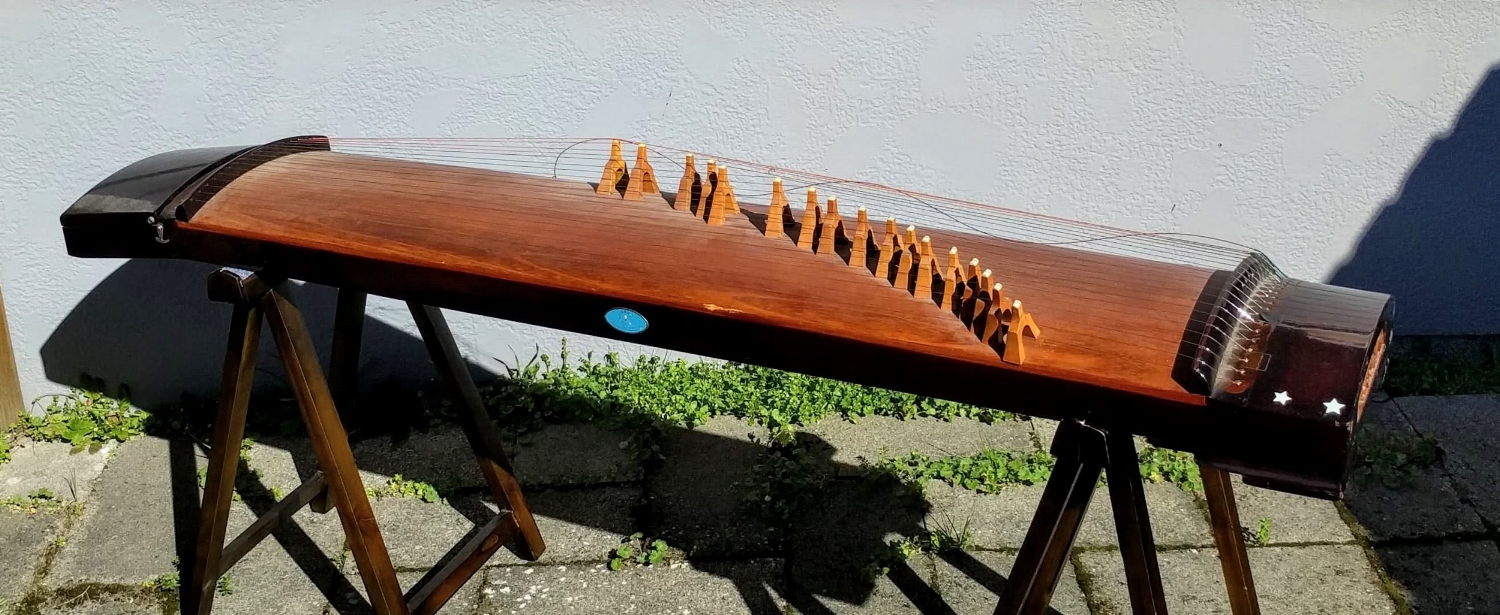18 Strings, Steel
As the government pushed for traditional instruments to take on a new form in post-war China, instrument makers added strings to the then common 16. Different changes spread at different speeds through different makers, creating surprising fusions of new and old. Here is one example of such an instrument. Built in the 1980s in Hong Kong this Skylark-brand instrument takes some of the innovations of the preceding decades in their own direction.
First up is its size: at just around 58 inches or 147 cm long, it's about as long as the modern "Travel Sized" guzheng made today. It has 18 strings of steel, with the 4 bass strings wound in copper to emphasize their depth. This is typical of the time, as makers sought to expand the zheng's range and sound qualities.
The fusion begins in the tuning compartment. Modern guzheng have strings anchored at the tail, running over the bridges, and affixing to tuning pins at the head of the instrument. This instrument reverses that: The head is now the access way for the string anchors, found behind a tight-fitting faceplate. The tail holds the tuning compartment, with tuning pins mounted off-vertical and hidden under a lengthy hinged lid.
This is an homage to the tuning pegs of old, as seen on the 16-string zheng from Taiwan. The pins are even designed to accommodate a tuning "key", a both a functional tool and an ornamentation and status symbol found in tombs from hundreds of years ago. This is really something!
If all that is not enough, the strings actually go through the fixed bridge on the tail, rather than resting on its top.
There are three other remarkable differences that set this instrument apart from other zhengs I have yet had the privilege to see in person, aside from the other 18-string zheng from Hong Kong:
1) The soundboard is finished. Most of the guzheng coming from Shanghai and other northern factories have soundboards that are mostly raw - that is, not much if any protective coating is added to their surface, and some are even brushed with wire to roughen them. This comes at a maintenance cost - if the surface is left raw water can easily penetrate it, causing local swellings that distort the sound of the instrument, and if left both raw and rough, dust can be trapped on its surface, muffling the sound. It's fascinating, then, to see that the zheng makers of the past went in a different direction. This instrument's soundboard has been coated to give it a furniture-like shine and some protective qualities, at the theoretical cost of part of its timbre.
2) The bridges have flat-mounted, thin tips. Again looking at modern bridges, most today have inset tip materials, commonly in rectangular or triangular shapes. Even compared to the other 18-string zheng from Hong Kong in the same collection, these tips are very thin.
3) The entire instrument is finished in a dark maroon lacquer, the same coating used to strengthen and protect Qin for centuries. This together with the combination of modern and traditional elements (18 strings but steel, tuning in compartment but using a key) suggest this instrument was designed to be a modern take on the instrument that emphasized its connection to the past.
Many thanks to Mr. Tang of Washington for allowing me time with this instrument.
And yes, this instrument's heaviest string is broken, near the far-right fixed bridge. With a little luck, a replacement will come soon!



